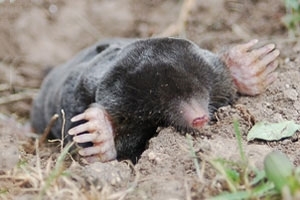European mole (Talpa europaea)
 If I told you that I knew a chap of around 15 stone and average height, but who eats 200lbs of meat a day and is so strong that he can push an object of three tons – would you believe me? If I also told you that he can be a real macho man and has fought other guys to the death, but despite this helps look after the children at home – who by the way look as though they take after him as they have grown from 8lbs at birth to 12 stone in just one month – would you think that this is just not possible and I’m making it all up? Well yes, in a way I am, but all I have done is relatively increased some facts about moles, so that they equate to a human. Amazing, isn’t it!
If I told you that I knew a chap of around 15 stone and average height, but who eats 200lbs of meat a day and is so strong that he can push an object of three tons – would you believe me? If I also told you that he can be a real macho man and has fought other guys to the death, but despite this helps look after the children at home – who by the way look as though they take after him as they have grown from 8lbs at birth to 12 stone in just one month – would you think that this is just not possible and I’m making it all up? Well yes, in a way I am, but all I have done is relatively increased some facts about moles, so that they equate to a human. Amazing, isn’t it!
Moles are powerful little beasties, with shovel-like, clawed front feet that face outwards, perfectly designed for digging the tunnels along which they travel and collecting worms that have fallen through as they go. In fact, so strong and cleverly positioned are these front limbs that moles have been recorded digging through more than 15 yards of soil in one hour (they can project a lateral force equivalent to 32 times their own body weight). But all this effort has a price to pay as moles have to consume between 70 and 100% of their own bodyweight every day and go about this by “working” for four hours and then having four hours sleep.
It is not just the mole’s front legs that are brilliantly designed – just about everything else to do with their body is as well! They have acute hearing and highly developed senses of both smell and touch, which combined help them to accurately detect food. However, their eyesight is very poor as it is not required in the total darkness they inhabit. They have no ears - just holes in the side of their heads – as ears would only get in the way as they squeeze along narrow tunnels. But it is their dark brown or black fur that is definitely worth a closer look, as not only is it totally waterproof, but it also lies without direction, enabling the mole to reverse back along its tunnel without discomfort. The fur is, of course, also wonderfully soft, which resulted in it becoming a highly prized commodity in the coat trade, with some 13 million skins being sold annually during the 19th Century.
During harsh winter weather or during drought conditions when the ground becomes rock hard, moles will burrow deep down following the worms to more permeable soil. It is here that they will usually build a nest, with many different routes leading to and from the chamber. Not far from this nest area there will often be sited a larder, where earth worms will be taken that have been bitten to render them unable to move but not killed, so as to supply fresh meat at times when food is short.
During the spring and summer months a particularly large molehill may be found among the other smaller hills (these normal- sized hills are simply the waste soil pushed out onto the surface to make more space underground), which is the breeding hill or “fortress”. Within this nest chamber 3-7 completely blind and hairless babies will be born and then suckled by their mother for around a month, in which time they will grow from 3.5 grams to 80 grams! Dad, in the meantime, will help out with the daily chores and also protect the surrounding tunnels vigorously, sometimes even fighting intruders to the death. Within two months the youngsters start to dig for themselves and become independent, and by the time they are one year old, they can produce young of their own.
So, although moles can be annoying when they scatter their hills across the lawn (it was this very reason that made me think of them as the topic for this scribbling!) they are in fact one of nature’s greatest designs – so much so, that when translated into human terms they become “fantasy beings”!
Peter Thompson
Advisory

Download Peter Thompson's essential 26-page book, featuring beautiful photography and detailed profiles of Britain's wildlife
Download FREE >